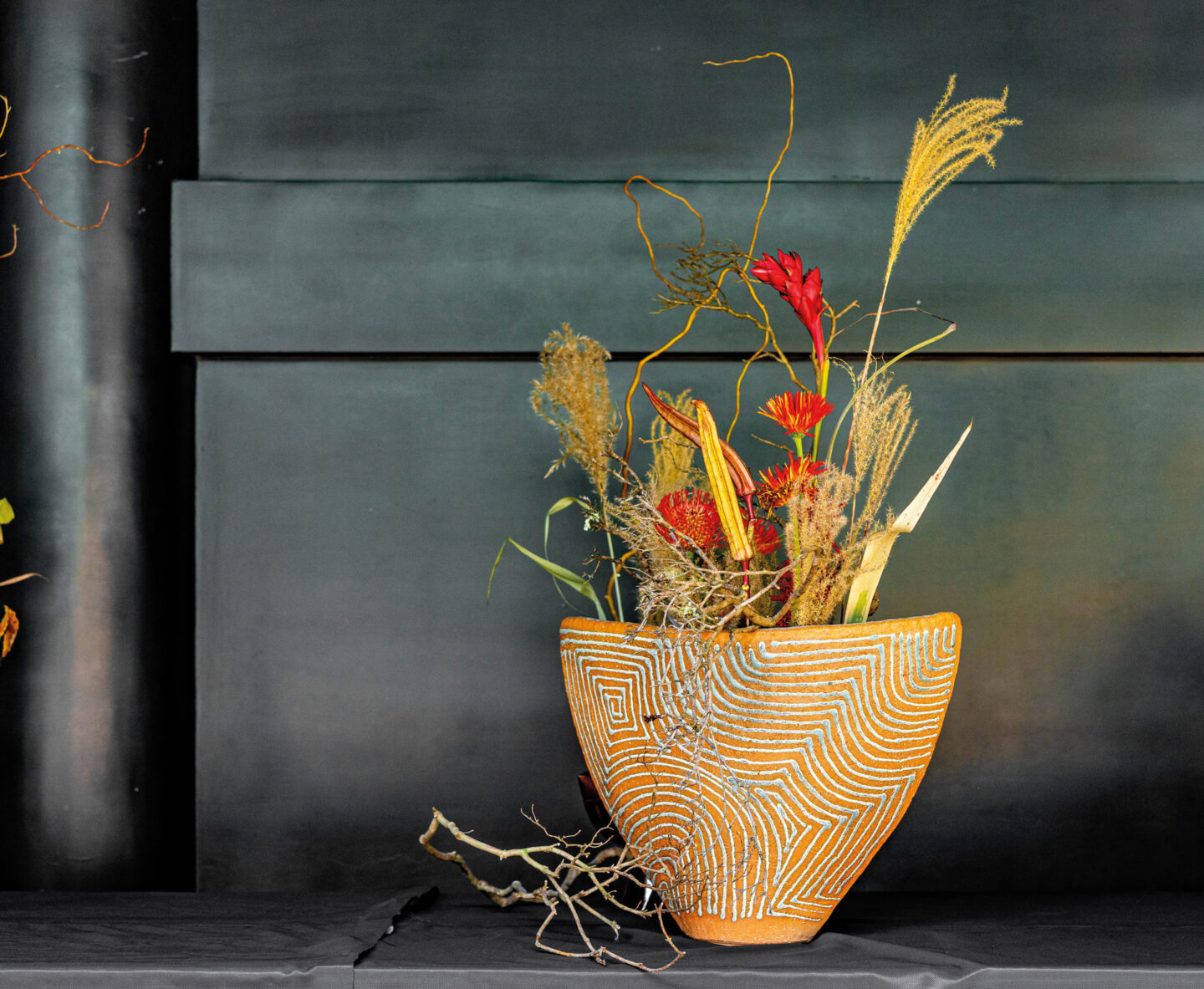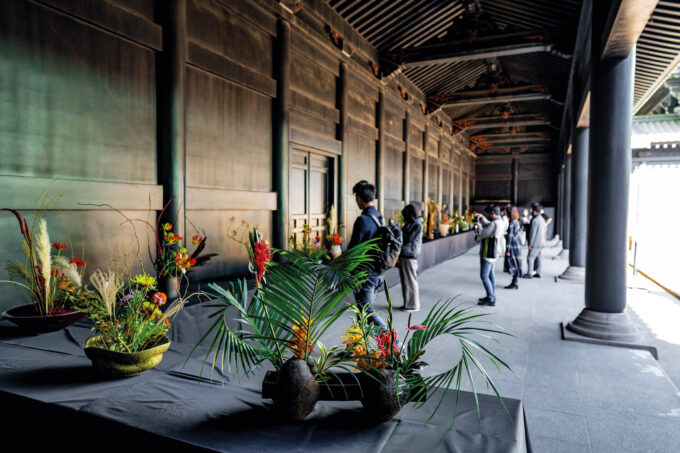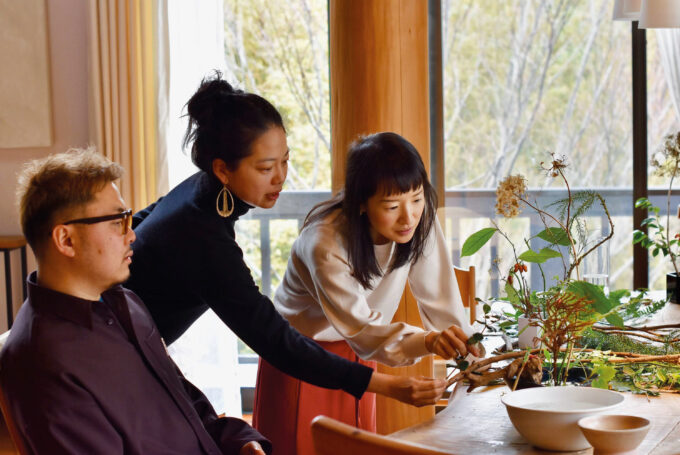
Technology is not only for the young
Too many organizations assume late-career workers can’t keep up with new technology. In doing so, they are ignoring a hugely important labor pool....

by Mayuka Yamazaki Published 13 October 2023 in Team building • 12 min read •

Let flowers live. That’s the concept that lies at the heart of ikebana, the traditional art of Japanese flower arrangement. Every time you hold a flower in your hand, you think about how you can help it look as beautiful as possible and in harmony with the other flowers. “Think” may not be the right word, though. After years of practice, your body moves instinctively to cut the flower and place it in the vase, without even thinking. It is as if your body knows how to let the flower live before your head does. If your ego starts kicking in, thinking, “I want to create a great ikebana work”, it becomes about you, not the flowers, and you end up failing to let the flowers live. Ikebana is the art and practice of continuously letting go of your ego and being attuned to the voice of flowers.
I have practiced ikebana for decades while working in management consulting and for a business school. Until very recently, ikebana was something very personal and private, something I just enjoyed doing in the small, closed ikebana community. But I started to observe that the nature of management studies and leadership education was changing, and there were more and more overlaps between what I had learned in ikebana and what was being researched and taught in business schools. What if I could bridge these two worlds, ikebana and business, and let them learn from each other? That’s why I founded IKERU in 2017 with the mission to bring the wisdom of ikebana to business and leadership education. For the past few years, through offering various ikebana programs, I have seen the positive impact that it can have on organizations and leaders.
So, what can ikebana teach today’s businesses? Why is it important for leaders to learn from this ancient practice?
Ikebana cannot be traced back to one moment or tradition in history. It is said that ikebana is inspired by both Buddhism and Shintoism, where the former arranges flowers and serves the Buddha statue and the latter sets up a specific tree branch to welcome the Divine. Also, in the old days, people enjoyed collecting flowers and arranging them in a vase, as documented in the Japanese essay Makura no Soshi, written around 1,000 years ago by a high-ranking court lady who served the empress: “A big blue-green precious vase was placed at the terrace and quite a few exquisite cherry-blossom branches were put in the vase. The cherry flowers were so in bloom that they were overflowing from the terrace.”
Gradually, arranging flowers evolved from a simple daily routine that anyone could do to a more sophisticated practice in which you needed to dedicate time to learn techniques and its philosophy. It was recorded that, in the 14th century, there were people known as “flower masters” who were widely recognized for their flower-arranging skills and were sometimes invited by powerful samurai lords and court nobles to arrange flowers on their estates. One of the oldest existing ikebana textbooks was published in the 16th century by a then well-known flower master who defined ikebana as the “art of letting the true nature of nature emerge in the vase” and illustrated how to put it into practice.

Ikebana has survived as Japan has undergone a series of enormous social transformations: from a feudal medieval society where clans were constantly engaged in military conflicts to the unified, peaceful but strictly hierarchical pre-modern society in the 17th to 19th centuries; from the drastic Westernization and modernization of the late 19th and early 20th centuries to the recovery from the devastation of the Second World War and the emergence as a global economic power.
Regardless of the era, the Japanese have practiced ikebana and deepened their relationship with it in their own way, leading to diverse definitions and principles. For example, different perspectives exist around the relationship between humanity and nature. Some believe that we understand the truth of nature and that ikebana is a way for us to express this truth. Others believe nature is perfectly beautiful as it is, and human intentions and interventions should be kept to the minimum. There are also different theories about how much individual creativity should be used. Some believe there is no room for individual creativity as ikebana is about practicing established balance formulas called kata until they are deeply ingrained, while others believe we should allow spontaneous and creative collaboration with the flowers. Among those who put greater importance on human creativity, some masters have tried to redefine ikebana as modern art – to the extent that they sometimes replace the flowers with artificial materials (called “avant-garde ikebana”).
There is, therefore, no single definition for what ikebana is – every definition should be respected and appreciated. But, for me, the philosophy of “letting flowers live” seems to lie at the heart of the art, cutting across many ikebana disciplines and making it distinct from the practice of flower arrangement in the West.
What do I mean by “letting flowers live”? Each flower is cut and placed in the vase in a way to make it look as authentically beautiful as possible. For that, we need to find the right angle, length, and location for each flower. Here, the definition of “right” becomes important. If we think of “right” as the flower being a perfect part of the work we are going to make, we are not letting the flower live – it is just being used to make what we want to make. Instead, we must try to see how the flower can become as beautiful as it can be. It must be placed in a way that creates harmony with the other flowers in the vase. By focusing on this, we are able to see the entire work emerge in a natural way.

“For us to let flowers live, we must exist with them, without having a pre-set vision of what we want to create.”
For us to let flowers live, we must exist with them, without having a pre-set vision of what we want to create. The stem’s curve might be the most charming part of the flower, but if we already have a plan in our head, the curve might not look right and we might cut the stem short to remove that curvature. Instead, if you can appreciate the flower as it is, you might see that it is unique and beautiful because of the stem’s curve, and you might find a way to let the curve shine within the entire work. This is letting flowers live: letting go of our desire to control, letting go of our ego, and existing in the present.
This is why cultivating our minds is the most important part of ikebana. Skills and techniques are, of course, important but they can be naturally developed over time if you keep practicing. Other Japanese traditional arts such as the tea ceremony, calligraphy, martial arts, and archery also share this philosophy.
I began studying ikebana when I was at college and continued to practice it as my weekend hobby after I embarked on my career in management consulting in the early 2000s. Ikebana was like an oasis for me during that sleep-deprived and over-stimulative phase of my career. On the weekend, through trying to let flowers live and letting go of my ego, I found tranquility and was able to return to my hyperactive job feeling deeply recharged. It never crossed my mind that ikebana would become my career or have anything to do with the business world. Ikebana was a beautiful practice I had to protect and keep away from my hectic work life.
Things started to look different around 2010. I was working at Harvard Business School (HBS) as a researcher based in Japan. Having gone through deep self-reflection after the Great Recession and various discussions about the school’s future during its year-long centennial forums in 2008, HBS reached the conclusion that it should transform itself to keep fulfilling its mission, “Educate Leaders Who Make a Difference in the World”, over the next 100 years. The school came up with a guiding principle – “Knowing, Doing, Being” – and revised its two-year MBA curriculum based on that code. The school emphasized that “being”, which is to understand who you really are and what you believe in, would be like a compass for life – without it, one would get lost and might end up making a negative difference in the world. I was genuinely and pleasantly surprised by the fact that HBS, “a capital of capitalism”, officially announced that cultivating the mind was the most important thing for future leaders. For the first time in my life, I saw there was a possible connection between ikebana and business.

I began to see a pattern forming: that mindfulness became an increasingly popular research topic in management studies as well as a practice in the real business world as seen in, for example, Google’s Search Inside Yourself program. Research showed that mindfulness could boost employees’ productivity, creativity, and well-being and that it was also linked to leadership effectiveness. While the term mindfulness was used almost as a synonym of meditation, I thought ikebana could become another powerful mindfulness practice for business. If mindfulness is about existing and remaining in the present, ikebana is indeed the very practice of mindfulness: we cannot let flowers live without being “present” in the moment. Further, given the more creative and dynamic nature of ikebana, I realized it could become a mindfulness practice that might appeal to those, who like me, found difficulty with meditation.
At the time, Ikebana was known for its tremendous, inherent wisdom but it was appreciated mainly in the realm of culture. What if I could bridge the gap between ikebana and business and let managers access opportunities to learn from the wisdom of the art of flower arranging? It might also help redefine and reinvigorate ikebana, which had faced the challenge of an aging and declining population of practitioners, for a whole new audience and generation.
So, in 2017, I left HBS, where I had worked for 10 fulfilling years, and founded IKERU with a mission to bring the wisdom of ikebana to business. “Ikeru” is a Japanese verb used in ikebana which implies that arranging flowers is about “letting flowers live”. I developed an ikebana workshop for corporate training, in which a team of three to four people would create one ikebana work, and began introducing the concept to companies.
In the workshop, each member of the team is responsible for one type of flower and members take turns to arrange their flowers as if passing the baton in a relay race.

I have developed five guiding principles of team ikebana based on the traditional wisdom of ikebana (see box below). The process can feel quite different from a typical team collaboration in a business setting where colleagues typically discuss and agree upon a goal, identify tasks to achieve it, assign a task to each member, and make sure that no one deviates from a given task. In this setting, the team knows where it is going and can measure where it is in relation to that goal. Individuals might also intervene while other members are still working on their tasks.
In the workshop, team ikebana participants are always amazed to see the outcome of their work, as it is often far more beautiful and dynamic than their initial expectations. They learn the power of respecting and trusting other members, accepting others’ perspectives (even if they initially disagreed), and appreciating what is emerging during the moment. Most importantly, the workshop reminds them of why we work together. We work together because we can go to a place where we cannot go alone. And working together means expanding how you see the world by accepting and internalizing how others see it.
Participants also deepen their understanding of themselves. They might notice their hesitation to cut a flower because they are afraid that they will not be able to come back once the cut is made – a fear of making a mistake. They might feel irritated about not being able to intervene when another member is arranging a flower – a habit of impatience and micromanagement. They might be surprised to find that they actually enjoy ikebana, an art of creating something beautiful, using not their logical thinking capability but their artistic sensitivity.

Do not discuss or plan beforehand what your team is going to create. Always just pay attention to what is emerging in front of you.
Let each team member focus on their own dialogue with their flower. If you notice something, say it in a way not to disrupt their focus.
Even if you do not agree with the flow the previous member created, accept it without judgment and play with that flow.
When it is not your turn, check the balance and flow of the whole work.
Once all members have finished their turns, look at the work as a team and see whether there are parts that should be fixed. If the team agrees about changing something, make sure that the member who arranged it in the first place fixes it.
For the past few years, dozens of companies, business schools, and non-profit organizations have implemented the team ikebana workshop. I have received feedback that the experience has helped to change team dynamics and the quality of collaboration.
Convinced that the wisdom of ikebana is relevant to business and can be a powerful tool to boost collaboration and leadership development, I have started to work with a mindfulness-based leadership development firm to create a longer-term global leadership program in which ikebana plays a central role. I have also worked with the HR team of the company where I serve on the board to integrate ikebana into its leadership development plan. Knowing that a one-time ikebana workshop can make such a profound impact, I am truly excited about what these longer programs can bring to business.
While I have worked on bringing ikebana into the corporate setting, I have also offered ikebana lessons to individuals, designing sessions so participants can be fully immersed in the experience of letting flowers live, not distracted by the formalities and rules that have been prevalent in the traditional ikebana world. My IKERU community includes people as diverse as professionals, entrepreneurs, and artists in their 20s to 50s, both male and female – a stark contrast to the existing ikebana schools where the majority of practitioners are women over 60.
If you are deeply in the flow of ikebana, you focus on letting each flower live and then realize later that the whole work emerges in front of you naturally and instinctively. You do not know

No organization can escape the need to transform to become more sustainable. The need to act is urgent. It calls for strong leadership, difficult decisions, and deep cultural change. In Issue XI, we explore how to build sustainable organizations to succeed in turbulent times.

Iikebana artist and the founder of IKERU
Mayuka Yamazaki is an ikebana artist and the founder of IKERU, an initiative to bring the wisdom of ikebana to business and leadership development. She also works as a Harvard Business Review Diamond Fellow and is an external director of three public companies, including Ryohin Keikaku (MUJI). Prior to that, Mayuka worked at Harvard Business School and McKinsey & Company.

27 June 2024 • by Tomoko Yokoi in Team building
Too many organizations assume late-career workers can’t keep up with new technology. In doing so, they are ignoring a hugely important labor pool....

6 May 2024 • by Michael D. Watkins in Team building
Here are seven questions to ask as you select the top team to lead your company. ...

9 February 2024 • by George Kohlrieser in Team building
In today’s high-stakes business world, striking a balance between being approachable and authoritative is tricky. George Kohlrieser explains in seven steps how to become an authentic and effective leader. ...
 Audio available
Audio available
2 February 2024 • by Patrick Flesner in Team building
Both micromanagement and a hands-off approach have their pitfalls. Navigating this balance is crucial. These two frameworks provide a roadmap to find the optimal level of involvement. ...
Explore first person business intelligence from top minds curated for a global executive audience